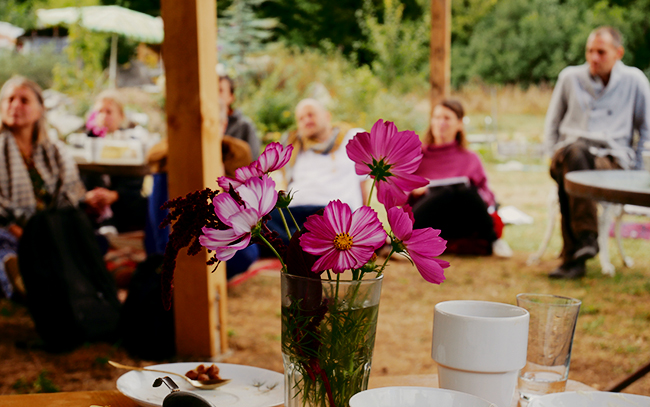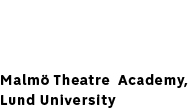 Photo © Steinunn Knúts Önnudóttir
Photo © Steinunn Knúts ÖnnudóttirEco-sustainable Performative actions
By La Saula (Saul García-López)
WELCOME
I would like to knowledge my ancestors and the Sámi as one people, as the Indigenous people of the Fennoscandian region. I want to pay respect to the deep knowledge of land and water, as well as to the spiritual principles and world perspectives that have and continue to inspire Sápmi across all of its communities.
AIM
Living collective embodied interactions focuses on breaking down power dynamics and challenging the normative structures and conceptions that govern our everyday interaction with nature and peers. The aim is to discover how our bodies get transformed when we recognize our surrenders therefore to generate new cartographies of radical interactions and interpretations with the environment and our communities. I propose to explore the spatial elements around us with visual embodied interactions that can engender more liberating and integral relationships with the space. My invitation is to conceive the body as an extension of the site, the spinal cord and the generator of actions that blend our actions with the environment. I invite you to experience the environment not only with your consciousness driven by the mind but also with your consciousness driven by the senses.
DISCLAIMER
In order to honour my ancestors, I recognize that in the next reflective story telling my arguments and perspectives I don´t only incorporate Indigenous epistemologies but Eurocentric model of thought and theoretical approaches. In this way, I recognize the bias of my ideas. It is an inherent part of living between the boundaries of Eurocentric epistemologies, non-binary thinking, Indigenous knowledges, and other ways of thinking in the world.
I depart from a simple concept: The beauty and struggles that take place in the world also take place in our bodies. So, the first step is to acknowledge our bodies and become aware of our interactions with the space, thus allowing our bodies to become part of our environment.
Our bodies are our only home; the only site, space, structure we have control over, and our multiple identities that emerge from our body consciousness, when purposely oriented, can become a powerful force that help us realign ourselves to the natural forces inherent in the land.
By becoming aware of our body and senses as a way to integrate to our environment, we need to become aware of each element and fragment in the space and accept them as a total self. This experience is one that can be a galvanizing force because it can transform our relationship to the site in a way that is much more holistic.
I particularly observe the space focusing on all the elements around me wondering about their specific purposes and functionalities, I look for my place in the site, the place my body can harmoniously occupy, and I meditate how by placing my body, I blend with the site specificities creating a new relationship between my body and the elements around me. I consider this kind of intervention a way of decolonizing and queering the space to confront my own ignorance or assumptions regarding the physical configurations around me and their functionality/purpose. In this way we can open a territory for more balanced relationships, reinterpretations and emancipatory realizations in the ways and forms I retrieve my place in the site.
We ourselves have to re-learn how to interact with the environment because humanity has focused on the “benefits” of the industrial revolution and the forces of consumerism. The destructive capitalism has created a devastating force of exclusionary illusion that separate us from the land and each other.
“UTOPIAN” or “DYSTOPIAN” THOUGHTS
With this personal reflection, what I am trying to convey is the epistemological principle of Indigenous thinking based in holism, the promotion of human beings as a whole person, as integral part of their ecosystem, where vernacular and cognitive knowledge is valued together with self-awareness, emotional growth, social growth, and spiritual development.
Let´s understand our environment as a palimpsestic space that allows for new knowledge and understanding to emerge. A space where transfer and connection of knowledge and the deconstruction and reconfiguration of meanings takes place in a fluid manner, a queer space that includes the constant movement/interaction of bodies in the space.
We also need to expand our view of abundance, meaning that there are adequate resources for everyone and everything to live sustainably so long as we govern human relationships in accordance with our environment. There is no need to fight over resources. As humanity, we have not understood this primary lesson yet.
We live in relation with everything, with the life force that supports and nourishes life. Relationality is a central concept within Indigenous worlds; all our relations are the material and spiritual foundations of culture.
Creating collective experiments where experiential instants emerge by allowing ourselves to immerse in all the entities, things, elements of specific places, is a way of retrieving life and giving life simultaneously. Thus, we construct a fluid, abundant and self-sustainable temporary relation and structure for learning, resting, reflecting and coming together.
We need to re-learn how to connect indigenous stories and experiences as a guiding path towards knowledge, relying on the relationships between people and nature with holistic interconnectedness. Thus, nurturing vernacular knowledge acquired through methods of introspection and curiosity.
Indigenous education involves oral traditions (such as listening, watching, imitating), group work, apprenticeship, and high levels of cultural context. It is through observation, imitation, use of narrative/storytelling, collaboration, and cooperation, that we learn all together. This is a living practical approach that emphasizes direct experience and learning without separating ourselves from our environment and the collective.
To be in the moment, fully aware of our simultaneous relationships with our environment decentralizes power and disrupts the stagnant centre opening up the possibilities of new forms of relations. This fluid imaginary-relationship is represented by the constant metamorphosis between space, environment and body.
POLITICAL IMPLICATIONS
It is not easy to negotiate an environment where pro-capitalist and anti-capitalist criticism confuses us and forces us to think why the unlashed market economy´s equally seductive and corrosive force seems to have no alternative today.
We need to design collective experiences to transcend the traditional notions of private property and ownership prevalent in the context of modernity, reflect in the various impacts of global climate and geological change and the essential relationship between traditional and future practices. We are trying to hark back and reconfigure to our times, the life style of our ancestors, a natural life.
Our bodies need to actively work with the site and its memories to deconstruct and disentangle the invisible from the visible, exposing power as it is distilled into social rules and conceptions of the environment – into hierarchy, in other words.
Self-sufficiency, knowledge distribution, time and labour management, are values that bring people together and closer to a harmonic relationship with the environment. The challenges of our times forces us to conceive new forms of collaboration connecting individuals with one another with a common objective and identity.
DREAM 739
I dreamt that I was in an “orgy” with 24 “red”, “brown”, “yellow” and “black” humans of complex genders. We couldn’t understand each other but we started to communicate by creating powerful imaginary with our bodies letting our alternate selves blend and take over the space around us, expelling the ghosts of irrational consumerism (take-use-discard and get a new one), thus transforming our relationship with each other and the world.
About the Author
Saul Garcia-Lopez, aka La Saula, is a queer multidisciplinary performance artist, Professor of Performance at the Norwegian Theatre Academy, and co-artistic director of the internationally renowned performance troupe La Pocha Nostra. He is dedicated to expose, dislocate and challenge assumptions of embodiment, gender, identity and representation within an intercultural and trans-cultural context. As an artist, pedagogue and scholar, he explores the intersections of the theoretical framework of performance theory and training. From this position, La Saula tries to expose and reconcile the contradictions and challenges of being a creator and a theorist at the same time. His research interest reaches acting, directing and performance theory and pedagogy including indigenous approaches from the Americas, the embodiment of gender, ethnic, national identity, stereotypes and representation, indigeneity, post-coloniality, and decoloniality.

